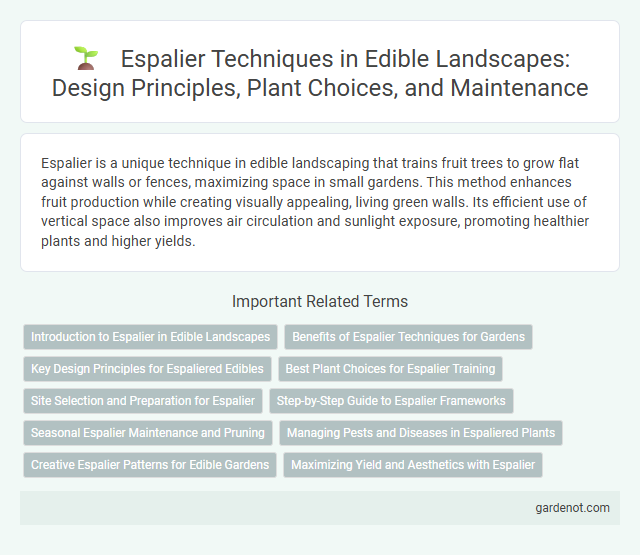Espalier is a unique technique in edible landscaping that trains fruit trees to grow flat against walls or fences, maximizing space in small gardens. This method enhances fruit production while creating visually appealing, living green walls. Its efficient use of vertical space also improves air circulation and sunlight exposure, promoting healthier plants and higher yields.
Introduction to Espalier in Edible Landscapes
Espalier is a horticultural technique that trains fruit trees to grow flat against a structure, optimizing space in edible landscapes. This method enhances air circulation and sunlight exposure, improving fruit quality and yield while creating visually appealing garden designs. Espaliered trees are ideal for small gardens or urban settings, maximizing productivity without sacrificing aesthetics.
Benefits of Espalier Techniques for Gardens
Espalier techniques maximize garden space by training fruit trees to grow flat against walls or trellises, enhancing sunlight exposure and air circulation for healthier plants and higher yields. This method simplifies pruning and harvesting while creating attractive, structured greenery that integrates aesthetic appeal with functional food production. Espalier also helps protect crops from wind damage and conserves moisture, contributing to more sustainable and efficient garden management.
Key Design Principles for Espaliered Edibles
Espaliered edibles require key design principles such as selecting suitable fruit tree varieties like apples, pears, and figs that respond well to pruning and training against support structures. Proper plant spacing and training methods ensure optimal sunlight exposure and air circulation, which enhance fruit production and reduce disease risk. Using strong, durable supports like trellises and wires is essential for maintaining structured growth and facilitating easy harvests in edible landscapes.
Best Plant Choices for Espalier Training
Apple, pear, and fig trees rank among the best plant choices for espalier training due to their flexible branches and strong growth habits. Stone fruits like peaches and plums also thrive when carefully pruned and trained along a flat surface, enhancing fruit production and sun exposure. Hardy vines such as grapes can complement these trees, offering diverse edible yields while maximizing limited garden space.
Site Selection and Preparation for Espalier
Choosing a site with full sun exposure and well-drained soil is crucial for successful espalier fruit tree growth. Preparing the site involves removing weeds, loosening the soil to improve aeration, and incorporating organic matter like compost to enhance nutrient availability. Proper site selection and soil preparation ensure healthy root development and optimal fruit production in espaliered plants.
Step-by-Step Guide to Espalier Frameworks
Creating an espalier framework involves selecting a sturdy, vertical support structure such as a trellis or wire system, spaced evenly to guide branch growth. Begin by planting fruit trees or edible shrubs close to the framework, pruning young shoots to encourage horizontal growth along each tier or wire. Regular maintenance, including seasonal pruning and tying branches to the framework, ensures optimal airflow, sunlight exposure, and fruit production within the edible landscape.
Seasonal Espalier Maintenance and Pruning
Seasonal espalier maintenance involves targeted pruning to enhance fruit production and maintain the desired shape, typically performed during late winter while the tree is dormant. Pruning focuses on removing dead or crossing branches, thinning out vigorous shoots, and cutting back new growth to encourage airflow and sunlight penetration. Proper seasonal care promotes healthy growth, increases fruit yield, and ensures the structural integrity of the espalier framework throughout the year.
Managing Pests and Diseases in Espaliered Plants
Effective management of pests and diseases in espaliered plants involves regular monitoring for common issues such as aphids, scale insects, and fungal infections like powdery mildew. Employing organic treatments like neem oil or insecticidal soap helps control infestations while preserving plant health and environmental safety. Maintaining proper air circulation and pruning damaged branches reduce the risk of disease development, ensuring the longevity and productivity of the edible landscape.
Creative Espalier Patterns for Edible Gardens
Creative espalier patterns transform edible gardens into visually stunning and space-efficient landscapes by training fruit trees and vines against walls or trellises. Designs such as fan, candelabra, and cordon espalier maximize sunlight exposure and air circulation, enhancing fruit production and plant health. Incorporating espalier techniques in small urban gardens boosts yield while adding architectural interest to the green space.
Maximizing Yield and Aesthetics with Espalier
Espalier techniques transform walls and fences into productive edible landscapes by training fruit trees to grow flat against surfaces, maximizing space efficiency and sunlight exposure. This method enhances fruit yield in small gardens while creating visually appealing, architectural forms that blend functionality with beauty. Proper pruning and maintenance promote healthy growth and abundant harvests, making espalier ideal for urban and compact garden settings.
Espalier Infographic

 gardenot.com
gardenot.com